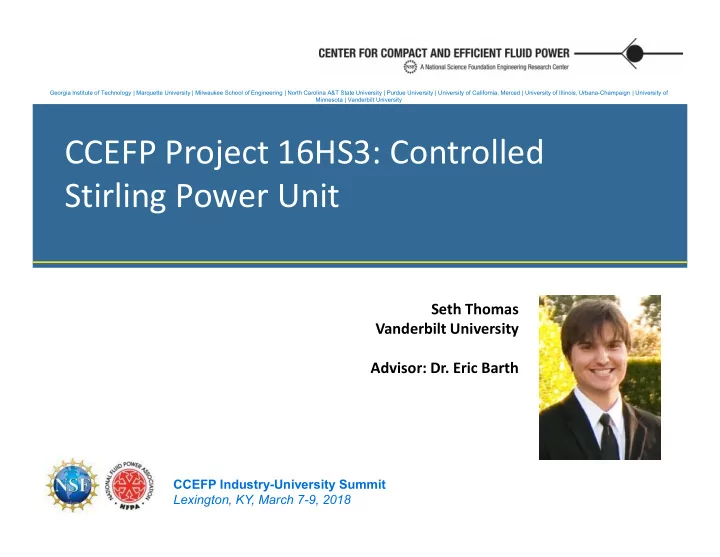

Georgia Institute of Technology | Marquette University | Milwaukee School of Engineering | North Carolina A&T State University | Purdue University | University of California, Merced | University of Illinois, Urbana-Champaign | University of Minnesota | Vanderbilt University CCEFP Project 16HS3: Controlled Stirling Power Unit Seth Thomas Vanderbilt University Photo Advisor: Dr. Eric Barth CCEFP Industry-University Summit Lexington, KY, March 7-9, 2018
Outline • Project Overview • Methods of Control – Controlled Displacer Motion – Controlled Inter-Unit Mass Flow • Potential Applications • Next Steps • Conclusion 2
Controlled Stirling Power Unit • Capable of using heat from many different sources, including waste heat. • Output power can be hydraulic, pneumatic, mechanical, or electric • Virtually noiseless operation • Low maintenance • Efficient (Stirling cycle approaches Carnot efficiency at high temperatures and pressures) • Thermodynamics can be controlled 3
Stirling Engine Cycle Thermocompressor Arrangement Power Piston 4
The Beale Number Controlled Displacer Piston Decoupled from power piston • Multiple motion profiles • Output power (watts) Median operating pressure (Pa) Power piston frequency (Hz) Volume displaced by power piston (m 3 ) � 5
Model and Verification �� T wall,h P h , V h , T h Q cond T flow,h � � V h , � x d V k , � Q � � � � shuttle x d Q loss � Q ��� cond T flow,k T � � flow , h P k , V k , T k � T wall,k � ��� 𝑝𝑣𝑢 , T out 𝑗𝑜 , T in � � � 6
Controlled Displacer Thermocompressor Thermocompressor Low pressure Low pressure tank tank High pressure High pressure tank tank 7
The Beale Number Controlled Mass Flow Controlled Displacer Piston Pressure controlled from • Decoupled from power piston • mass injected at strategic stages Multiple motion profiles • Output power (watts) Median operating pressure (Pa) Power piston frequency (Hz) Volume displaced by power piston (m 3 ) � 8
Controlled Inter-Unit Mass Flow Ideal Stirling Cycle Pressure 1. Isothermal Process (Work Out) 2. Isochoric Process 1. 3. Isothermal Process (Work In) 4. Isochoric Process 2. 4. 3. Volume 9
Inter-Unit Mass Flow Simulation 10
Inter-Unit Mass Flow Simulation Steady State Adjusted Steady-State Pressure Pressure Number of Stages kPa psia kPa psia 1 165.2 24.0 145.6 21.1 2 317.8 46.1 253.2 36.7 3 604.8 87.7 453.9 65.8 4 1,089.6 158.0 789.8 114.5 5 1,791.5 259.8 1,266.9 183.7 6 2,674.0 387.9 1,855.3 269.1 11
Conceptual Architecture Stirling Stirling Engine Thermocompressor Stirling Engine Stirling Engine Power Piston Power Piston Power Piston Displacer Piston Displacer Piston Displacer Piston Displacer Piston Flywheel Common Load Flywheel 12
Conceptual Architecture Mass Input Pressure Power Piston Stirling Thermo- Displacer compressor Piston Displacer Piston Mass Output Relative Phases Volume 13
Simulation Results 𝝆 𝟐𝟕 radians Mass Flow Window 42.94 cm 3 Modelled Power Piston Displacement Frequency 1 Hz Median 16.57 bar Operating Pressure Net Power 7.97 watts Output (no mass flow) Net Power 18.86 watts Output (mass flow) Relative 2.92 watts Power (18.34%) Gain 14
Controlled Mass Flow Window Range 15
Potential Applications Increased Power Density in Multi-Engine Systems Image Credits on Last Slide 16
Potential Applications Increased Power Density in Multi-Engine Systems Image Credits on Last Slide 17
Next Steps • Validate Controlled Mass Flow Simulation Results with Experimental Data – Install Linear Alternator on Current Stirling Thermocompressor to make a Traditional Stirling Engine – Emulate Thermocompressor Pressure Oscillations Using Reservoirs Held at High/Low Temperatures, Pressures – Regulate Mass Flow using Control Valves • Experimentally Validate Full Control of Stirling Engine Linear Alternator 18
Conclusions • A control strategy for increasing power output from Stirling devices using controlled mass flow from accompanying Stirling thermocompressors was introduced and simulated. • Simulation results corroborate that power output can be greater using an engine-thermocompressor arrangement than with an equivalent pair of Stirling engines. Experimental validation is forthcoming. • Contact Information: – Seth Thomas • benjamin.s.thomas@vanderbilt.edu – Dr. Eric J. Barth • eric.j.barth@vanderbilt.edu 19
Additional Image Credits 30 kW Maintenance Free Stirling Engine for High Performance Dish Concentrating Solar Power . (2010). (Presentation Slides) Available: https://www1.eere.energy.gov/solar/pdfs/csp_prm2010_infinia_30kw.pdf Mason, L., McClure, P., Gibson, M. and Poston, D. (2018). Kilopower Media Event . (Presentation Slides) Available: https://www.nasa.gov/sites/default/files/atoms/files/kilopower-media- event-charts-final-011618.pdf Wang, U. (2018). Gigaom | Solar Stirling startup Infinia looking to raise $25M . [online] Gigaom.com. Available at: https://gigaom.com/2011/08/29/solar- stirling-startup-infinia-looking-to-raise-25m/ [Accessed 8 Mar. 2018]. 20
Recommend
More recommend